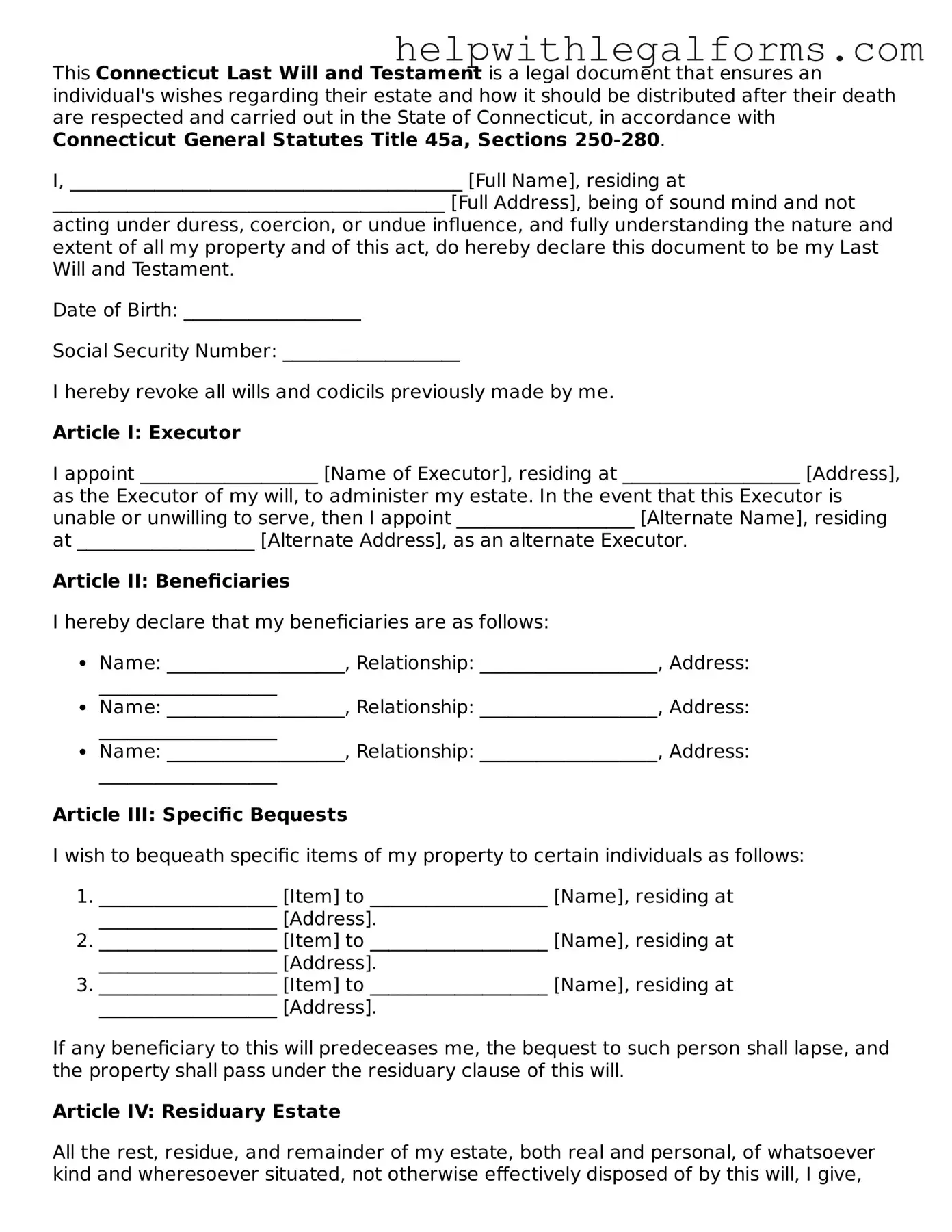This Connecticut Last Will and Testament is a legal document that ensures an individual's wishes regarding their estate and how it should be distributed after their death are respected and carried out in the State of Connecticut, in accordance with Connecticut General Statutes Title 45a, Sections 250-280.
I, __________________________________________ [Full Name], residing at __________________________________________ [Full Address], being of sound mind and not acting under duress, coercion, or undue influence, and fully understanding the nature and extent of all my property and of this act, do hereby declare this document to be my Last Will and Testament.
Date of Birth: ___________________
Social Security Number: ___________________
I hereby revoke all wills and codicils previously made by me.
Article I: Executor
I appoint ___________________ [Name of Executor], residing at ___________________ [Address], as the Executor of my will, to administer my estate. In the event that this Executor is unable or unwilling to serve, then I appoint ___________________ [Alternate Name], residing at ___________________ [Alternate Address], as an alternate Executor.
Article II: Beneficiaries
I hereby declare that my beneficiaries are as follows:
- Name: ___________________, Relationship: ___________________, Address: ___________________
- Name: ___________________, Relationship: ___________________, Address: ___________________
- Name: ___________________, Relationship: ___________________, Address: ___________________
Article III: Specific Bequests
I wish to bequeath specific items of my property to certain individuals as follows:
- ___________________ [Item] to ___________________ [Name], residing at ___________________ [Address].
- ___________________ [Item] to ___________________ [Name], residing at ___________________ [Address].
- ___________________ [Item] to ___________________ [Name], residing at ___________________ [Address].
If any beneficiary to this will predeceases me, the bequest to such person shall lapse, and the property shall pass under the residuary clause of this will.
Article IV: Residuary Estate
All the rest, residue, and remainder of my estate, both real and personal, of whatsoever kind and wheresoever situated, not otherwise effectively disposed of by this will, I give, devise, and bequeath to ___________________ [Name], residing at ___________________ [Address].
Article V: Guardian
In the event that I am the parent or legal guardian of minor children at the time of my death, I nominate ___________________ [Name], residing at ___________________ [Address], to act as the guardian of said minor children. Should ___________________ [Name] be unable or unwilling to serve, I nominate ___________________ [Alternate Name], residing at ___________________ [Alternate Address], as alternate guardian.
Article VI: Signatures
I, ___________________ [Your Name], the testator, sign my name to this will this ___ day of _____________ [Date], at ___________________ [City], ___________________ [State], in the presence of the witnesses, attesting to this will, who signed it at my request, and in my presence.
___________________ [Your Signature]
Witnessed by:
- Name: ___________________, Signature: ___________________, Date: ___________________, Address: ___________________
- Name: ___________________, Signature: ___________________, Date: ___________________, Address: ___________________
- Name: ___________________, Signature: ___________________, Date: ___________________, Address: ___________________
This Last Will and Testament was signed and declared by ___________________ [Your Name], as the testator's Last Will and Testament, in the presence of us, who in their presence, and at their request, and in the presence of each other, have hereunto subscribed our names as witnesses. We declare under penalty of perjury under the laws of the State of Connecticut that the foregoing is true and correct, and that at the time of the signing the testator appeared to us to be of sound mind and memory.
